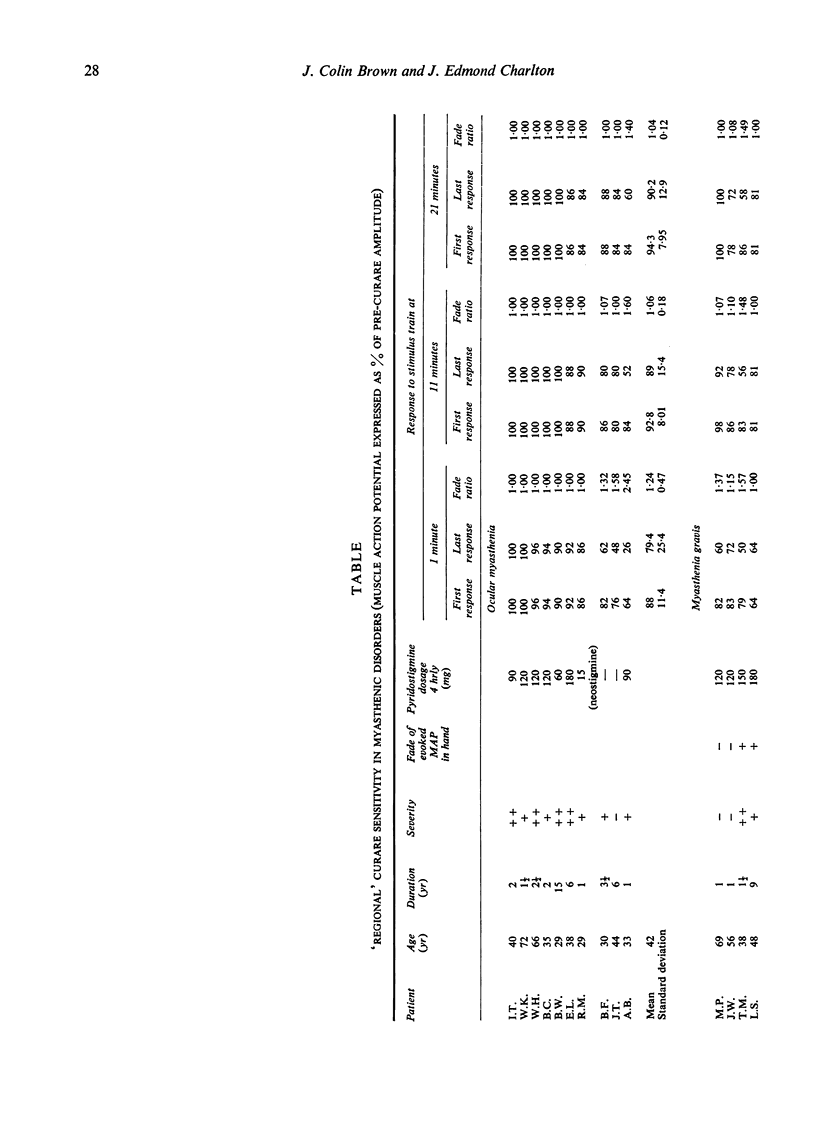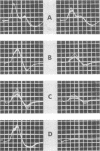Abstract
A study of curare sensitivity has been made in ocular myasthenia, myasthenia gravis, and the myasthenic syndrome sometimes associated with carcinoma, using a regional technique. Sensitivity is greater than in normal subjects. The injection of 0-125 mg d-tubocurarine resulted in a neuromuscular transmission block in all but a few of those cases with ocular myasthenia and in all cases of generalized myasthenia. Furthermore, the block persisted for longer than in normal subjects after the release of the tourniquet. This sensitivity to curare was not directly related to myasthenic weakness. The reasons for this are discussed and an explanation for such curare sensitivity is suggested.
Full text
PDF






Images in this article
Selected References
These references are in PubMed. This may not be the complete list of references from this article.
- Brown J. C., Charlton J. E., White D. J. A regional technique for the study of sensitivity to curare in human muscle. J Neurol Neurosurg Psychiatry. 1975 Jan;38(1):18–26. doi: 10.1136/jnnp.38.1.18. [DOI] [PMC free article] [PubMed] [Google Scholar]
- Brown J. C., Johns R. J. Clinical and physiological studies of the effect of guanidine of patients with myasthenia gravis. Johns Hopkins Med J. 1969 Jan;124(1):1–8. [PubMed] [Google Scholar]
- ELMQVIST D., HOFMANN W. W., KUGELBERG J., QUASTEL D. M. AN ELECTROPHYSIOLOGICAL INVESTIGATION OF NEUROMUSCULAR TRANSMISSION IN MYASTHENIA GRAVIS. J Physiol. 1964 Nov;174:417–434. doi: 10.1113/jphysiol.1964.sp007495. [DOI] [PMC free article] [PubMed] [Google Scholar]
- Elmqvist D., Lambert E. H. Detailed analysis of neuromuscular transmission in a patient with the myasthenic syndrome sometimes associated with bronchogenic carcinoma. Mayo Clin Proc. 1968 Oct;43(10):689–713. [PubMed] [Google Scholar]
- Feldman S. A., Tyrrell M. F. A new theory of the termination of action of the muscle relaxants. Proc R Soc Med. 1970 Jul;63(7):692–695. doi: 10.1177/003591577006300716. [DOI] [PMC free article] [PubMed] [Google Scholar]
- GROB D., HARVEY A. M., JOHNS R. J. Studies in neuromuscular function. VI. Effects of anticholinesterase compounds, d-tubocurarine, and decamethonium in patients with myasthenia gravis. Bull Johns Hopkins Hosp. 1956 Oct;99(4):219–238. [PubMed] [Google Scholar]
- Grob D., Namba T., Feldman D. S. Alterations in reactivity to acetylcholine in myasthenia gravis and carcinomatous myopathy. Ann N Y Acad Sci. 1966 Jan 26;135(1):247–275. doi: 10.1111/j.1749-6632.1966.tb45475.x. [DOI] [PubMed] [Google Scholar]
- OTSUKA M., ENDO M. The effect of guanidine on neuromuscular transmission. J Pharmacol Exp Ther. 1960 Mar;128:273–282. [PubMed] [Google Scholar]
- PELIKAN E. W., TETHER J. E., UNNA K. R. Sensitivity of myasthenia gravis patients to tubocurarine and decamethonium. Neurology. 1953 Apr;3(4):284–296. doi: 10.1212/wnl.3.4.284. [DOI] [PubMed] [Google Scholar]
- Takamori M., Gutmann L. Intermittent defect of acetylcholine release in myasthenia gravis. Neurology. 1971 Jan;21(1):47–54. doi: 10.1212/wnl.21.1.47. [DOI] [PubMed] [Google Scholar]




